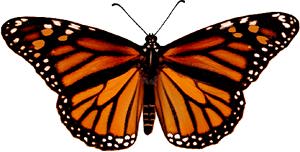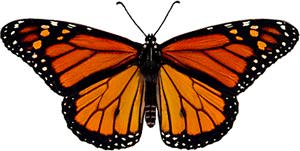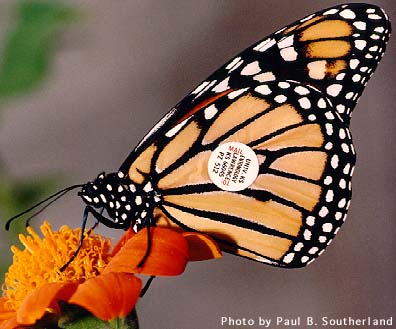
Monarch Butterfly Information
On September 13, 1999, students and guests from the Hollidaysburg Veterans Home tagged and released monarch butterflies from the Keith steps. This marked the "kick-off" for our link with Mission Butterfly.
Our visiting guests included: Dr. Robert Snetsinger (Butterfly Bob), Robert Ruggery (Bob the Bug Man), Commandant David Langguth, Carole Ruggery, Sandy Woytowiec and veterans Jim Maley, Rick Urgolites, and Dave Perrine.
Most of the monarchs were furnished by our guests; however, Mrs. Buck caught about 15 for the occasion. Students worked in threes: tagging the insects, recording the tag numbers and releasing them for their winter migration to Mexico.
We plan to have another butterfly release toward the close of school -- as we complete our projects for the HVH.
Female Monarch Butterfly

Female monarchs have thick vein pigmentation and no hindwing pouches.
Male Monarch Butterfly

Male monarchs have thin vein pigmentation and swollen pouches (scent glands) on the hind wings. (Note the 2 black "spots" on the backwings).
Tagging Of A Butterfly

A small, round, adhesive tag is carefully placed on the underside of the monarch's wing. The number on the tag is recorded. If the tagged butterflies are spotted during their migration, the numbers will be recorded on the website Monarch Watch- and we will be able to track our butterflies! These tags don't harm the butterflies or affect their ability to fly.
Milkweed Plant

Monarch larvae feed exclusively on milkweeds. They are perennial plants, which means that an individual plant lives for more than one year, growing each spring from rootstock and seeds. Milkweeds were historically common and widespread across the Midwest; but habitat destruction has reduced their range and numbers.
When monarch larvae ingest milkweed, they also ingest the plants' toxins- storing these poisons in their exoskeletons, making the larvae and adults toxic to potential predators. Vertebrate predators may avoid monarchs because they learn that the larvae and adults taste bad and make them vomit.
The common milkweed, pictured here, may grow between 60 to 200 cm tall, have opposite leaves and purple to pink flowers. Humans have used common milkweed in many ways. Native Americans pulverized the seeds to create a salve for sores. Seeds were also boiled and steeped in water to create a serum for drawing out rattlesnake poison. The fluff attached to the seeds, was experimented with by the U.S. Dept. of Agriculture to see if it could be used in Air Force floatation devices. The latex-like sap was also studied, as a possible rubber substitute.
The sap from common milkweed can seriously irritate your eyes, especially if you wear contacts. Be careful not to rub your eyes when collecting milkweed.
Fall Migration to Mexico

Monarch butterflies cannot survive a long, cold winter. Instead they spend the winter in roosting spots. Monarchs west of the Rocky Mts. travel to small groves of trees along the California coast. Those east of the Rocky Mts. fly farther south, to the forests high in the mountains of Mexico. The monarchs' migration is driven by seasonal changes: daylength and temperature. Monarchs are the only butterflies to make such a long two-way journey every year! They fly in masses to the same winter roosts, often to the same exact trees. Individual monarchs only make the round trip once. It is their children's grandchildren, that return south the following fall. Noone knows exactly how their remarkable homing system works. This is one of the many unanswered questions in the butterfly world!
Pictures of Monarchs Reaching Mexico

A "Blizzard" of Monarchs
People witnessing the monarchs' migration to Mexico often refer to their arrival as a "blizzard".

A Monarch Cluster on the Ground
Monarchs cluster together on the ground. People have to be careful where they walk during this time.

A Monarch Cluster on a Tree
From a distance, the monarch clusters look like grapes, as they drape over the branches and completely cover trees!